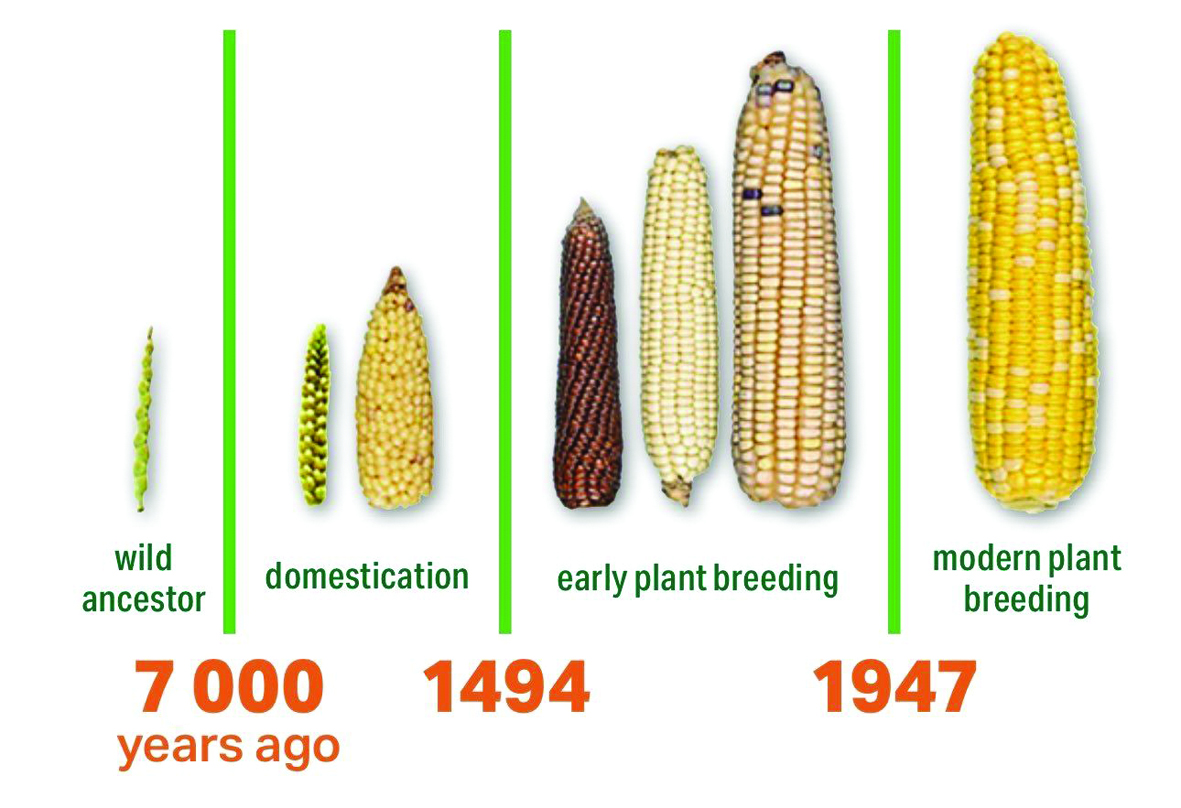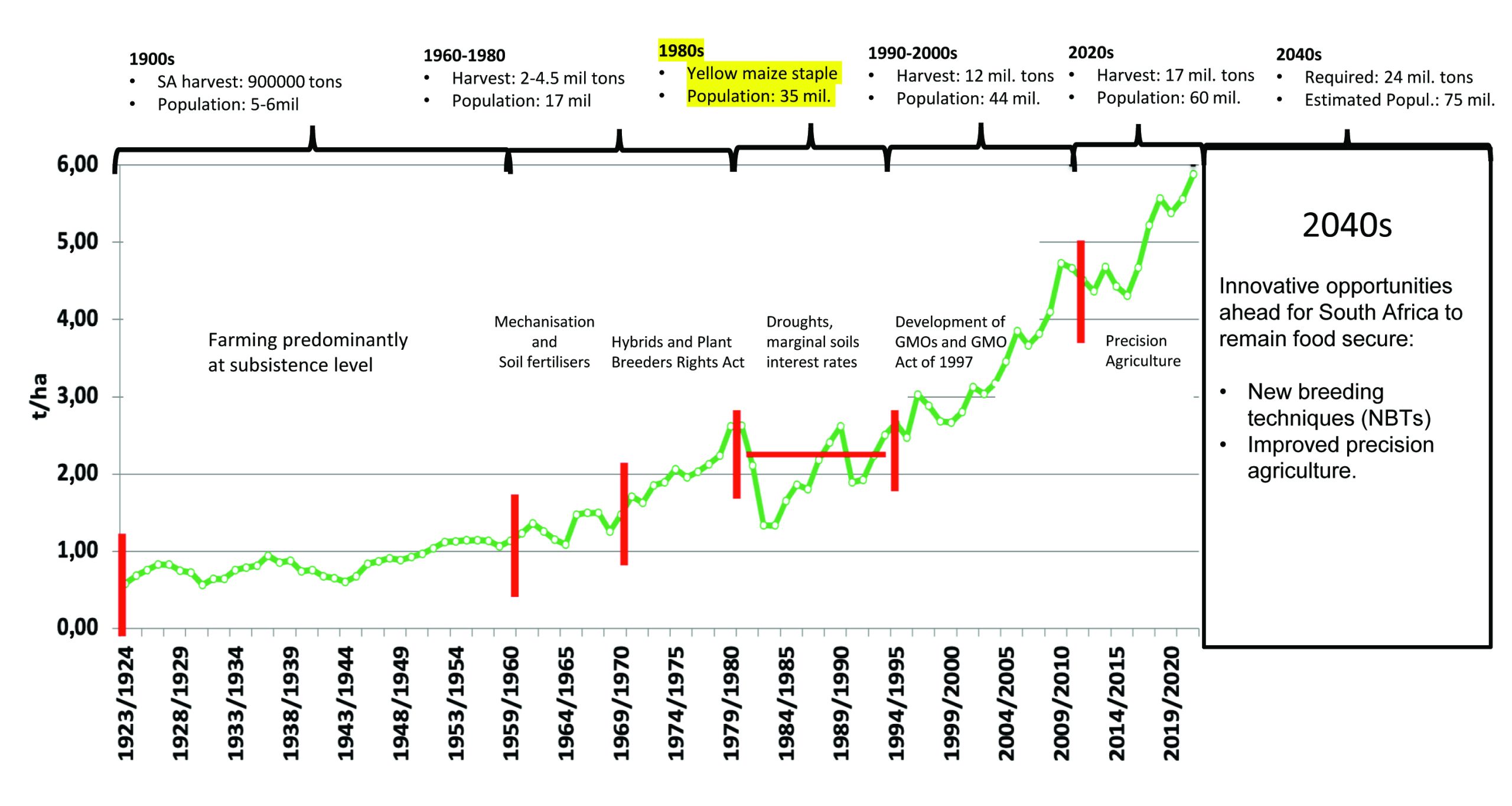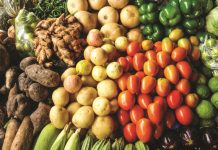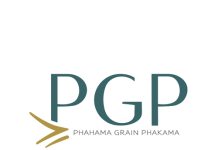
Maize is critical to food security in South Africa, contributing about 50 to 60% of the population’s carbohydrate intake. It is primarily consumed in the form of maize meal (mielie meal), which is used to prepare popular dishes like pap, enjoyed by people from various socio-economic backgrounds.
South Africa produces 15 million to 17 million tons of maize annually, covering 2,5 million to 3 million ha. This paper discusses how South Africa has met growing population demands over the past century. This has been done through innovations such as (i) improved agronomic practices through mechanisation, fertilisers, and pesticides; (ii) genetic gain through development of hybrids and GMOs; (iii) economics and commodity prices; and (iv) precision agriculture.
These innovations have significantly increased maize yields from 0,6 t/ha to 6 t/ha. However, with ongoing population growth and rising production costs, ensuring food security remains a challenge. Future yield improvements may depend on advancements in new breeding techniques (NBTs) and further precision agriculture innovations.
The evolution of maize breeding and its introduction to South Africa
Maize originated from the wild grass teosinte in Mexico around 7 000 years ago. It was selectively bred for larger kernels and reached Africa through trade routes in the 16th century, eventually becoming a South African staple (Figure 1).
In the early 1900s, the South African population was 5 million to 6 million, and maize production was primarily subsistence based, covering about 1 million to 1,5 million ha with low yields of 0,6 t/ha and a total harvest of around 900 000 tons. By the 1960s, with mechanisation, fertilisers, pesticides, seed treatments, and hybrid seeds, the cultivated area expanded to 2 million to 3 million ha, producing about 4,5 million tons with improved yields of 1,0 t/ha to 1,5 t/ha, as the population reached 17 million to 20 million.
In the 1980s, South Africa’s population of approximately 35 million relied on a stabilised maize production of 3 million ha, yielding around 2 t/ha. However, economic constraints and policies led to yellow maize becoming a cost-effective staple, widely used as animal feed and promoted as an affordable option for human consumption during white maize shortages or droughts to support food security.
The introduction of genetically modified maize in the 2000s further boosted yields to 3 t/ha to 4 t/ha (with a total harvest of 13 million tons), meeting the needs of 44 million to 47 million people. Today, because of improved seed genetics, sustainable practices, and precision agriculture, maize yields average 5 t/ha to 6 t/ha (with a total harvest of 17 million tons), sustaining South Africa’s population of 60 million and supporting food security.

Source: Dr Mamata Khandappagol

Source: Grain SA Applied Economics, adapted by Dr MG Kgatle
Regulatory framework of NBTs to boost productivity
Breeding in South Africa is managed under various stringent regulatory acts such as the Plant Breeders’ Rights Act (Act No. 15 of 1976), the Plant Improvement Act (Act No. 53 of 1976) and the Genetically Modified Organisms Act (GMO Act No. 15 of 1997). The Plant Breeders’ Rights Act offers intellectual property protection to encourage innovation, while the GMO Act ensures the safety of GMOs for human health, animal health, and the environment. Every maize cultivar that is released for public production is thoroughly tested for compliance, therefore discrediting the perception that these are cancerous or disease causing. These laws align with international standards, enhancing South Africa’s agricultural competitiveness, promoting sustainable farming, and ensuring food safety for consumers.
Maize breeding has evolved through three main stages, including traditional breeding, genetically modified organisms (GMOs), and new breeding techniques (NBTs). Traditional breeding, which has been practiced for thousands of years, involves selecting plants with desirable traits and crossbreeding them to pass these traits to the next generation. While this method has successfully improved maize over time, it is an unpredictable and time-consuming process that can take up to 15 years to achieve stable results for specific traits.
In the 1990s, GMOs transformed maize breeding by incorporating specific genes from other organisms. GMOs do not necessarily increase maize yield, but make for more effective agronomic practices, pest control (Bt gene) and weed control (Roundup). Both traditional breeding and GMOs have limitations in speed and complexity. Due to our improved understanding of plant genetics and physiology, NBTs offer a promising solution considering the South African production challenges ahead. These challenges include (i) the need to produce crops with higher yields to meet the projected demand of 25 million tons of maize by 2040; (ii) the increasing frequency of extreme environmental conditions, like nationwide delayed rains, and temperature fluctuations such as -5 °C in September and up to 40 °C by October 2024; (iii) summer rains delayed for up to six weeks; and (iv) severe droughts in the North West province.
NBTs allow for swift, targeted improvements in traits like drought tolerance and nutritional content, and could reduce some of the regulatory barriers faced by GMOs. This will also make new technologies more accessible and cheaper. While NBT (gene editing) creates new traits faster without introducing foreign genes, these still must be tested for their interactions and crop fit. NBTs are presently not used nor regulated in South Africa, highlighting a potential need for regulatory reform to support agricultural innovation.
South Africa’s food production challenge
While maize and soy production meet domestic needs, South Africa relies on wheat imports, making local food security vulnerable to global trade disruptions. Grain prices are tied to Safex, making local production viable only if it competes with international prices; otherwise, millers can import at lower prices than in the local market. However, importing would have huge consequences on the economy, labour (job security) and gross domestic product (GDP), not mentioning the impact on food security and the sustainability of being a grain import-dependent country. Relying on imports increases vulnerability, especially as international events like trade imbalances, pandemics (such as COVID-19), droughts, and conflicts create obstacles to reliable trade. These events can quickly shift an importing country from food security to food insecurity. GMOs have enhanced South African grain production’s competitiveness by reducing production costs and protecting genetic potential.
Conclusion
South Africa’s maize production has undergone significant advancements, from traditional breeding to the incorporation of GMOs and now the promising potential of NBTs. While traditional breeding and GMOs have played key roles in improving maize yields and resilience, NBTs offer a more precise, more affordable and rapid approach to enhancing traits like drought tolerance and nutritional content. Through advances in mechanisation, genetic modifications, and precision agriculture, South Africa’s maize sector has become more resilient in the face of population growth, increasingly extreme environmental conditions, and rising production costs.
The country’s reliance on imports for certain commodities, such as wheat, underscores the vulnerability of South Africa’s food security to global disruptions. Ensuring sustainable, local food production through technological advancements and regulatory frameworks is essential to safeguarding food security and maintaining job stability, given agriculture’s central role in the economy.



















